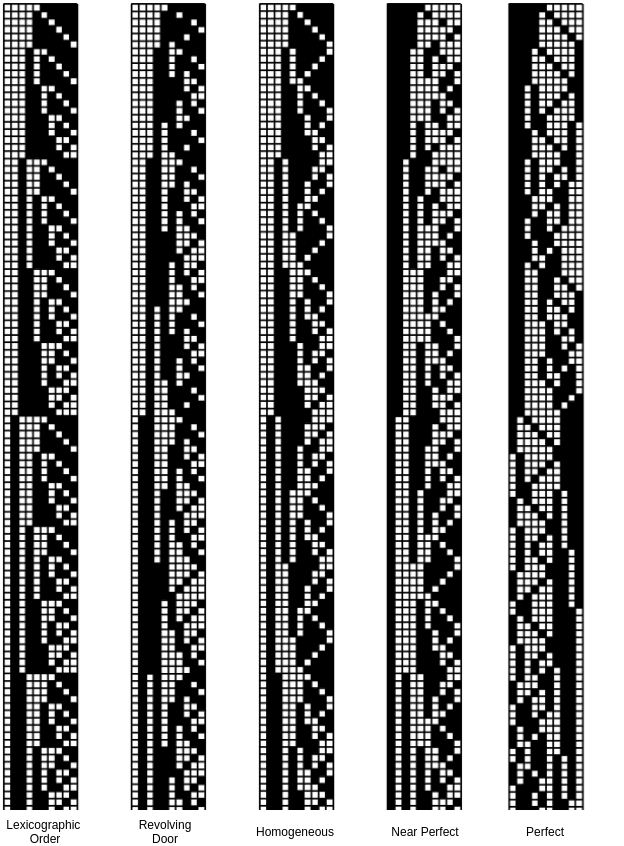1. 概述
在组合数学中,K 组合问题指的是:从一个包含 n 个元素的集合中,选出所有包含 k 个元素的子集(不考虑顺序)。这类子集的数量由二项式系数决定:
$$ \binom{n}{k} = \frac{n!}{k!(n-k)!} $$
虽然计算数量本身很简单,但要枚举所有这些子集却相对复杂。本文将介绍几种经典的生成算法,包括:
- 字典序生成(Lexicographic Generation)
- 背包生成(Filling a Rucksack Generation)
- 旋转门生成(Revolving Door Generation)
- 准完美方案(Near-Perfect Schemes)
- 完美方案(Perfect Schemes)
这些算法最早由计算机科学家 Donald Knuth 在《计算机程序设计艺术》(The Art of Computer Programming)中系统总结。
2. 字典序生成法
字典序生成法是一种直观且常用的生成方式。它将所有 k 组合按升序排列,便于查找和遍历。
核心思想
假设集合为 {0, 1, ..., n-1},我们以降序排列组合元素,例如 [2, 1, 0] 表示组合 {0, 1, 2}。
算法模拟了多层嵌套循环的逻辑。例如,k = 3 时,等价于以下 Java 伪代码:
for (int c3 = 2; c3 < n; c3++) {
for (int c2 = 1; c2 < c3; c2++) {
for (int c1 = 0; c1 < c2; c1++) {
visit(c3, c2, c1);
}
}
}
每次迭代中,我们找到最右边可以递增的元素 cj,然后将它后面的元素设置为最小值。
示例
当 n = 6,k = 3 时,生成顺序为:
210
420
510
532
310
421
520
540
320
430
521
541
321
431
530
542
410
432
531
543
3. 背包生成法
3.1 二项树(Binomial Trees)
该方法将组合问题建模为背包问题,并利用二项树(Binomial Trees)进行递归构造。
二项树 Tₙ 的定义如下:
- T₀ 是一个单节点
- Tₙ 由一个根节点和 n 个子树 Tₙ₋₁, ..., T₀ 组成
例如,T₄ 的结构如下:

Tₙ 中第 k 层的节点数等于 C(n, k),因此组合生成可以看作是 Tₙ 的第 k 层节点遍历。
3.2 背包算法实现
我们可以使用前序遍历的方式访问所有有效节点。核心逻辑是:
- 初始时选择 k 个元素
- 然后尝试在不超出容量的前提下添加新元素
- 若当前元素不再可用,回溯并尝试下一个可能的组合
4. 旋转门生成法
4.1 Gray 码简介
Gray 码是一种二进制编码方式,相邻两个编码只有一位不同。我们可以利用 Gray 码生成 k 组合,使得每次只变化一个元素。
4.2 旋转门算法实现
我们用一个长度为 n 的比特串表示当前组合:1 表示选中,0 表示未选中。每次只翻转两个比特(一个 1 和一个 0),模拟“旋转门”切换。
生成逻辑如下:
- 从全 0 开始
- 每次只交换一个 1 和一个 0
- 确保始终有 k 个 1
例如,n=6, k=3 时,生成的 Gray 码序列如下:
000111
011010
110001
101010
001101
011100
110010
101100
001110
010101
110100
100101
001011
010110
111000
100110
011001
010011
101001
100011
转换为组合后为:
210
431
540
531
320
432
541
532
321
420
542
520
310
421
543
521
430
410
530
510
可以看到,每个组合中元素交替递增递减。
5. 准完美与完美方案
5.1 准完美方案(Near-Perfect Schemes)
如果每次只改变一个组合元素(即只改变一个 cⱼ),我们称之为齐次序列(homogeneous sequence)。
旋转门算法并不满足这个条件,比如从 210 到 320 就改变了两个元素。
我们可以构造齐次序列,例如:
210 → 420 → 532 → 510 → 310 → 410 → ...
这种序列被称为 Chase 序列,是准完美方案的一种。
5.2 完美方案(Perfect Schemes)
如果每次只交换相邻两个比特(即只移动一个元素的位置),我们称之为完美方案。
数学家已经证明,完美方案只在以下情况存在:
- k ≤ 1
- n - k ≤ 1
- k × (n - k) 为奇数
也就是说,完美方案只在 4 分之一的情况下存在。
6. 算法对比
下图展示了不同算法生成组合时的二进制输出热图,清晰地体现了各种方法的规律性:

7. 总结
本文介绍了五种经典的 K 组合生成算法:
| 算法名称 | 特点 | 是否齐次 | 是否完美 |
|---|---|---|---|
| 字典序生成 | 简单直观,易于实现 | ❌ | ❌ |
| 背包生成 | 利用二项树结构 | ❌ | ❌ |
| 旋转门生成 | 使用 Gray 码,相邻只变一位 | ❌ | ❌ |
| 准完美方案 | 每次只变一个元素,变化范围 ≤ 2 | ✅ | ❌ |
| 完美方案 | 每次只交换相邻元素 | ✅ | ✅(仅在特定条件下) |
这些算法各有优劣,选择时应根据具体需求权衡性能与实现复杂度。